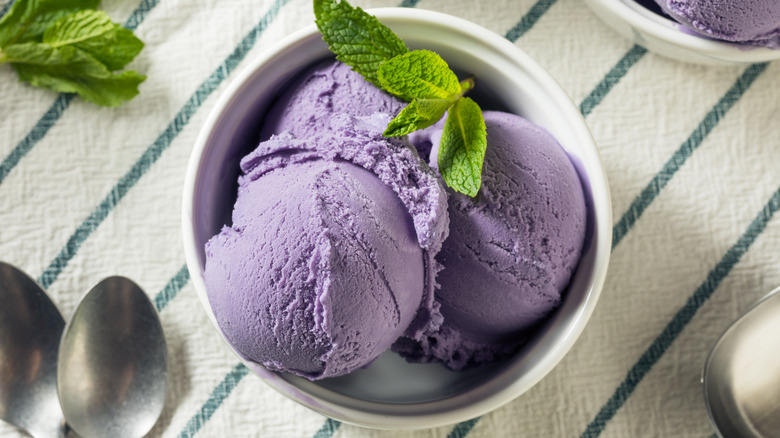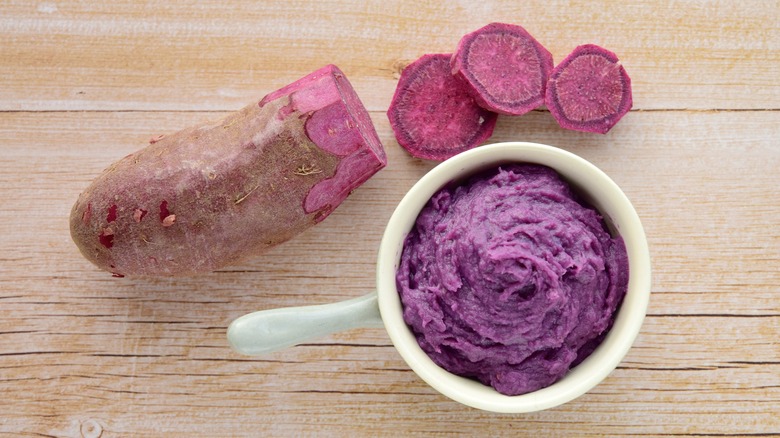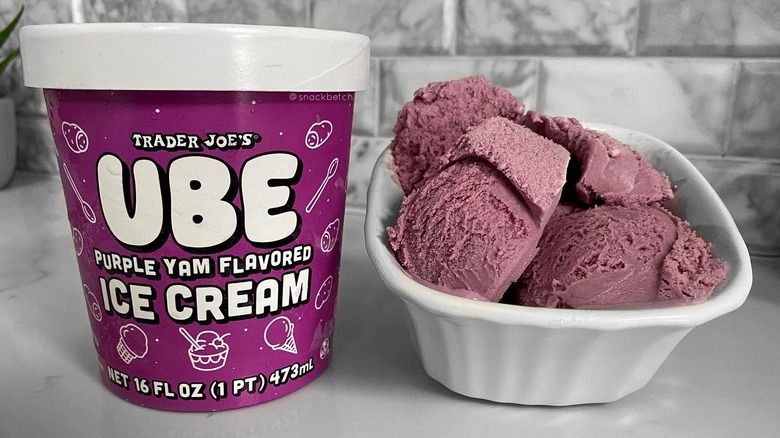The Fan Favorite Trader Joe's Ice Cream That Returns Year After Year
Seasonal ice creams (truly, seasonal products of all kinds) are a source of great joy — and great annoyance, perhaps despair — among Trader Joe's shoppers. There's elation when they return, and devastation when they inevitably vanish yet again. Such is the case with a certain purple frozen treat: Trader Joe's Ube Ice Cream. It's almost time for this fan-favorite flavor to be back in the freezer for a fleeting, delicious time.
Ube season at Trader Joe's has traditionally kicked off in April or May since the flavor first hit in 2019. Ube Pretzels were available in April, marking the start of the season, and shoppers can score a limited stock of Ube Tea Cookies and Ube Mochi Pancake and Waffle Mix now. Though Trader Joe's website doesn't list either the ice cream or the mochi ice cream as available yet, it's promising its return and hoping stock will last through mid-summer. Its appearance in ice cream form is creeping later and later; in 2022, it wasn't spotted by Trader Joe's Instagrammer @traderjoeslist until late June.
What is ube?
For the unsure and uninitiated, ube (pronounced ooo-bay) is a yam native to Asia and is especially popular in the Philippines. It's a tuber like potatoes and sweet potatoes, but instead of growing underground, ube grows on an above-ground vine. In addition to "ube," it also goes by the following names: Ratalu, khoai mỡ, ji abana, winged yam, purple yam, water yam, or sometimes, depending on where you are, just yam. Though ube does come in other colors and even marbled white and purple, the most common is bright purple.
Before commercialization, ube was considered sacred to the Bohol province, which produces 35% of the Philippines' ube. During the country's numerous occupations, ube fed native Boholanos who hid in the mountains. Legend has it that when famine struck, ube was the only food source. It's so revered that if a yam is dropped on the ground during harvest, it's said that Boholano farmers will kiss it and apologize.
And with the great love of the ube ice cream, Trader Joe's aficionados can likely understand why the tuber is so venerated among Filipinos. Beyond its historical importance, it's also beloved for its flavor: A melding of vanilla and pistachio with a hint of coconut. No wonder it's taken the U.S. by storm, from fluffy pandesal rolls to halo halo, Filipinos are no strangers to delicious cuisine, and now it's found right in TJ's Ube Ice Cream.
The growing popularity and scarcity of ube
Ube hit the U.S. food scene and became trendy in the mid-2010s and has only gotten more popular since. Unfortunately, as demand for ube grows, production wanes. According to the Philippine Statistics Authority, ube production fell from 30,074 metric tons in 2006 to 13,957 metric tons in 2020. Severe weather due to climate change is heavily to blame for this deficit, with cyclones creating conditions too waterlogged to grow ube some years and drought too serious to grow in others. Mon Yedra of the DA Agribusiness and Marketing Assistance Service (via meryenda) also cites "poor seed system, production, and post-production practices" as problems to be overcome with ube crop production. Ube has a single short growing and harvest window annually, making it a crop susceptible to trouble. With the global demand for the yam, the Filipino government is working to encourage its citizens to take advantage of the National Agri-Aqua Technology Business Incubation Program to grow successful agribusiness.
In the meantime, ube can be hard to find. Trader Joe's doesn't hide the fact that, because it uses real ube in its ice cream and other treats, it's very limited. "We can't get enough of it," its website states. "That's not a figure of speech; we truly can't. We have limited supply — hopefully enough to get us to mid-summer — so if you think you might have an appetite for Ube, find it while you can."


